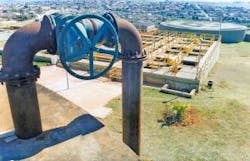Municipal drinking water plants in the U.S and Canada have thousands of projects underway to meet the need for more and better municipal drinking water. Each of these projects is being tracked from inception through operation in North American Public Water Plants and People. Large cities in the U.S. with populations of more than 100,000 are attempting to meet investment needs of $5 billion per year, whereas medium-sized communities have an even larger task.
Treatment requirements are 22% of the total investment. These include new plants, expansion of existing plants, replacement of obsolete systems and upgrading the plants to meet new regulatory requirements.
A typical project is one under discussion in Woonsocket, R.I. The city is under state and federal mandates to upgrade the Manville Road Water Treatment plant by March 2013 to eliminate the discharge of filtration pollutants into the Blackstone River and to improve the quality of drinking water.
Engineers from Camp Dresser McKee have proposed a $55 million plan that includes dismantling the existing plant and replacing it — at least for a time — with a pipeline that allows the city to buy drinking water from Pawtucket. The city would build a new water treatment plant on the site of the existing one perhaps two years later.
The alternative is to build a new plant just over the city line in North Smithfield. This second option comes with a slightly lower price tag — about $50 million — but it does not include what the city will end up paying in property taxes to North Smithfield.
Some of the states with the largest project activity are those with growing populations. California has annual project investment needs of $380 million.
The needs in Canada are substantial despite the much smaller population. Decades of cuts in infrastructure funding have resulted in a municipal infrastructure deficit, conservatively estimated at $123 billion by the Federation of Canadian Municipalities. Communities across the country are in desperate need of money to pay for water pipes and filtration systems, which is now the responsibility of municipal governments. Some governments have started looking to private investors to rebuild infrastructure through public/private partnerships.
The government of Canada announced the approval of 42 low-cost infrastructure loans for more than $192 million to 11 different municipalities throughout the province of Ontario as part of Canada's Economic Action Plan.
Source: McIlvaine Co.


